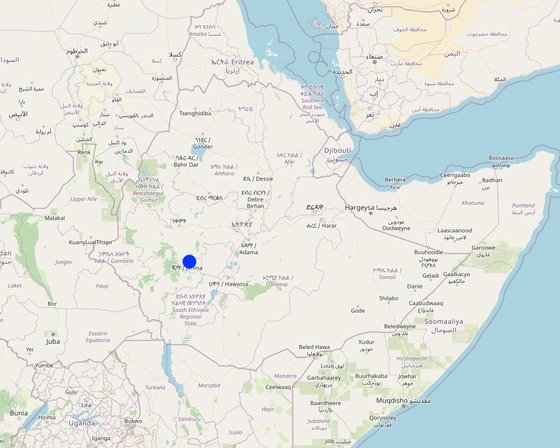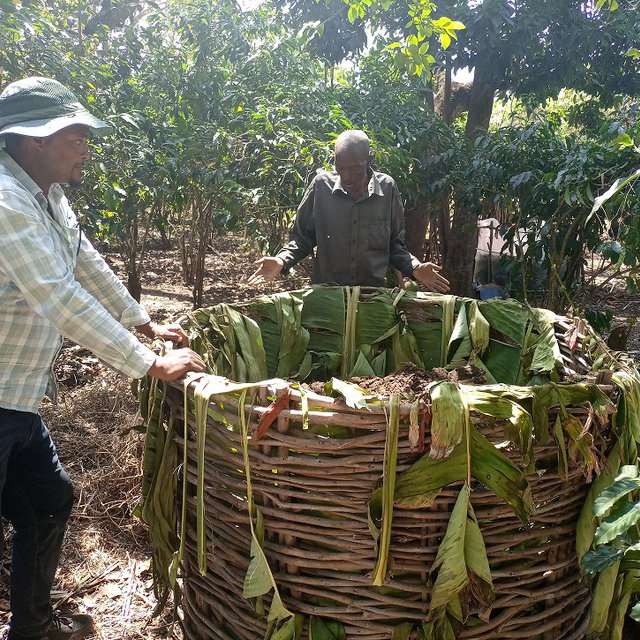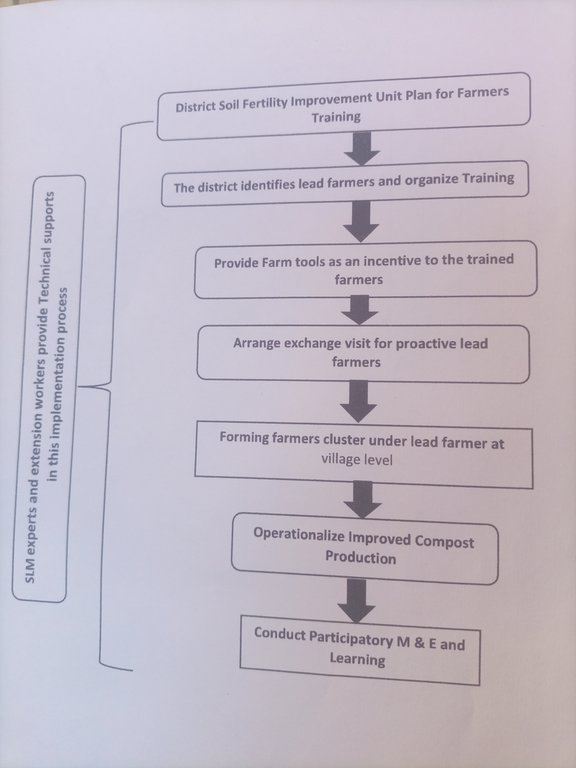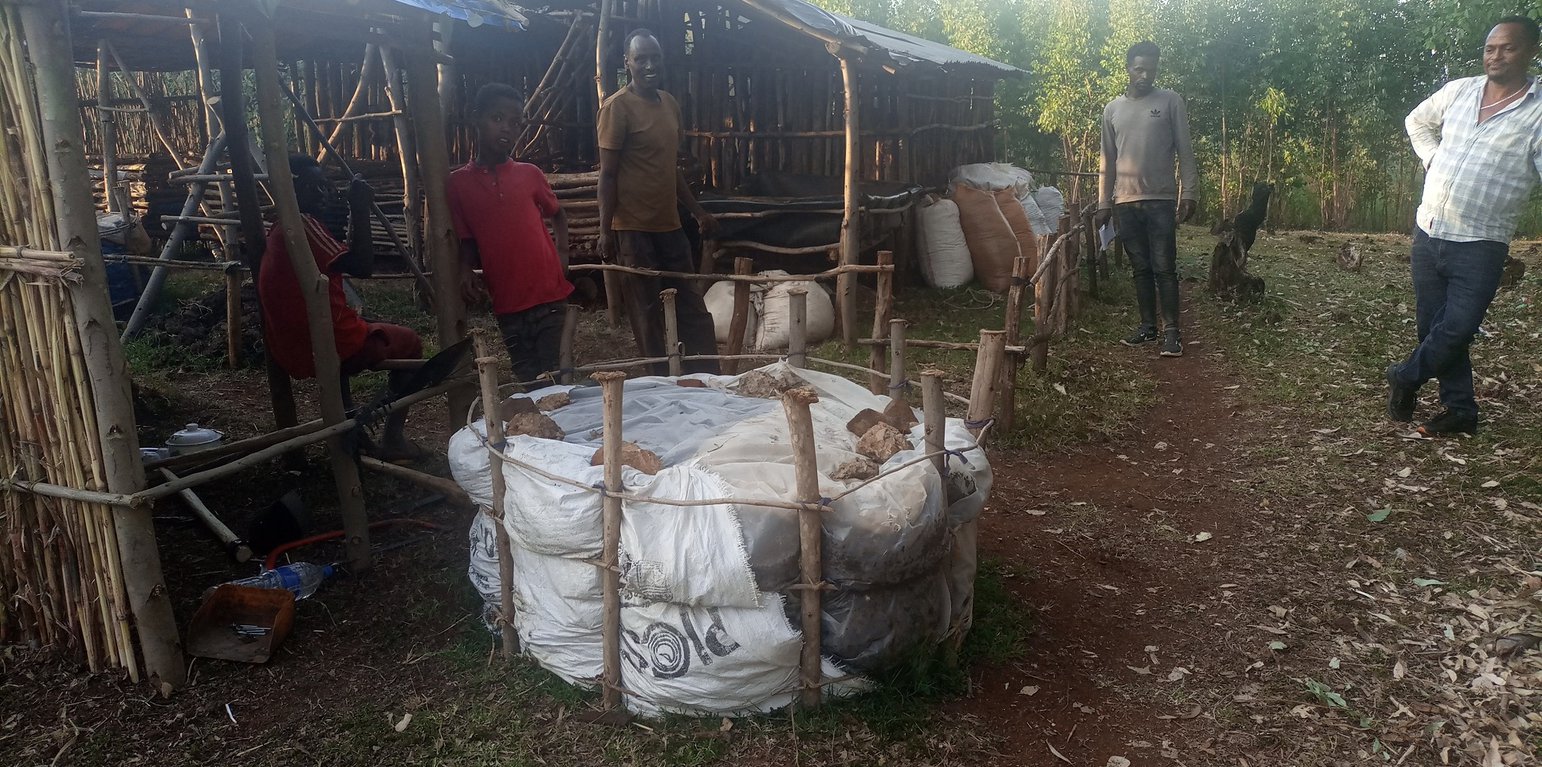Soil Fertility Improvement Cluster
(Ethiopia)
Foyyainsaa Gabbina Biyyee gareedhan
Description
The Soil Fertility Improvement Cluster approach engages five or more farmers living in a village who share skills and labour to prepare and use improved compost as well as to demonstrate it to non-member of the group.
The Soil Fertility Improvement Cluster approach engages five or more farmers living in a village who share skills and labour. Soil fertility improvement interventions in Kersa district of Jimma zone follows this approach. A cluster introduces diverse benefits to the participants including access to a package of inputs, and other benefits and services. Furthermore, it creates awareness and facilitates the adoption and diffusion of various soil fertility improvement technologies such as the preparation and use of improved compost. Kersa district, as one of the scaling out woredas for the Integrated Soil Fertility Management Project (ISFM+), strives to spread appropriate technologies against the growing issues of soil degradation, particularly soil acidity. The approach aims to promote collective learning and action where labour is shared amongst the participating farmers.
The district/Woreda Office of Agriculture’s Soil Fertility Improvement Unit organises annual training for 20 to 40 model farmers from different kebeles, of which five or more are located in the same village and can form a cluster. At the end of the training, the woreda office of agriculture donates a spade or other farm tool as an incentive to engage the participants in the preparation of organic fertilizers such as improved compost and vermicompost. Strict follow-up is carried out, with technical support provided by woreda development actors.
On top of the training organized on improved soil fertility by the woreda office of agriculture experts, a local NGO known as “FC Ethiopia” provides experience exchange visits to other parts of Oromia where improved compost was piloted. This technology involves different activities for the production of improved compost (described in detail as a Technology in the WOCAT database). Farmers' participation in training, exchange visits, collective learning and action, and lessons learning from the actual use of this organic fertilizer vis-à-vis using synthetic fertilizers motivates farmers to uptake and implement the technology. Land users like the simplicity of preparing the compost which takes less time than conventional compost preparation.
Location

Location: Babo kebele, Oromia, Jimma zone, Ethiopia
Geo-reference of selected sites
Initiation date: 2022
Year of termination: n.a.
Type of Approach
-
traditional/ indigenous
-
recent local initiative/ innovative
-
project/ programme based

Structure for improved compost production inside the backyard coffee plantation of a member of a cluster. (Gerba Leta)
Approach aims and enabling environment
Main aims / objectives of the approach
To learn and prepare improved compost in a group, and restore the increasingly growing problems of soil acidity, the main causes of soil degradation in the area.
Conditions enabling the implementation of the Technology/ ies applied under the Approach
-
Availability/ access to financial resources and services: It enables land users to easily source some necessary materials such as polyethylene sheet.
-
Institutional setting: Cluster formation at the local level enables collective learning and labor sharing among the participant farmers.
-
Collaboration/ coordination of actors: Simplify group learning and scaling up/out of the technology at a larger scale.
-
Knowledge about SLM, access to technical support: Farmers' cluster or group approach improves access to technologies and technical support. Moreover, it improves farmer knowledge about SLM.
-
Markets (to purchase inputs, sell products) and prices: It enables the farmers to produce surplus organic fertilizer and sell it out to those who require it.
-
Workload, availability of manpower: The availability of family labor simplifies the production and use of improved compost.
Conditions hindering the implementation of the Technology/ ies applied under the Approach
-
Workload, availability of manpower: The workload and shortage of family labor have a negative effect on the preparation of improved compost.
Participation and roles of stakeholders involved
Stakeholders involved in the Approach and their roles
| What stakeholders / implementing bodies were involved in the Approach? |
Specify stakeholders |
Describe roles of stakeholders |
| local land users/ local communities |
Farmers |
Collective learning and labor sharing. |
| SLM specialists/ agricultural advisers |
Woreda SLM experts and Kebele extension workers. |
Technical support and provision of advisory service. |
| NGO |
FC Ethiopia |
Arranged experience exchange visit for few farmers. |
Involvement of local land users/ local communities in the different phases of the Approach
none
passive
external support
interactive
self-mobilization
initiation/ motivation
SLM experts and extension workers provide technical support, and a group of farmers jointly learn and implement the technology.
planning
Extension workers engage in the planning process.
implementation
Farmers are keen to learn and implement the technology via group steering and self-mobilization.
monitoring/ evaluation
Woreda SLM experts, extension workers, and farmers engaged in participatory evaluation and learning in a cluster.
Flow chart
Process of implementing cluster-based improved compost production.

Author: Gerba Leta
Decision-making on the selection of SLM Technology
Decisions were taken by
-
land users alone (self-initiative)
-
mainly land users, supported by SLM specialists
-
all relevant actors, as part of a participatory approach
-
mainly SLM specialists, following consultation with land users
-
SLM specialists alone
-
politicians/ leaders
Decisions were made based on
-
evaluation of well-documented SLM knowledge (evidence-based decision-making)
-
research findings
-
personal experience and opinions (undocumented)
Technical support, capacity building, and knowledge management
The following activities or services have been part of the approach
-
Capacity building/ training
-
Advisory service
-
Institution strengthening (organizational development)
-
Monitoring and evaluation
-
Research
Capacity building/ training
Training was provided to the following stakeholders
-
land users
-
field staff/ advisers
Form of training
-
on-the-job
-
farmer-to-farmer
-
demonstration areas
-
public meetings
-
courses
Subjects covered
Improving soil fertility using organic fertilizers, acid soil management, crop residue management, crop rotation, etc.
Advisory service
Advisory service was provided
-
on land users' fields
-
at permanent centres
Advisory service is often given at Farmers Training Center (FTC) and complemented by field visit and provision of on- the- spot technical support and counseling services.
Institution strengthening
Institutions have been strengthened / established
-
no
-
yes, a little
-
yes, moderately
-
yes, greatly
Describe institution, roles and responsibilities, members, etc.
Farmers cluster (soil fertility improvement group). Member farmers jointly learn the technique of producing organic fertilizers, SLM practices, and sharing labor during the time of applying the fertilizer to the farm.
Type of support
-
financial
-
capacity building/ training
-
equipment
Further details
Monitoring and evaluation
The monitoring and evaluation are conducted by Woreda SLM experts and seldom with member of the woreda administration and the land users.
Financing and external material support
Annual budget in USD for the SLM component
-
< 2,000
-
2,000-10,000
-
10,000-100,000
-
100,000-1,000,000
-
> 1,000,000
Precise annual budget: n.a.
Actually, specific data for operational data is not available at the level of the compost production cluster since the training and exchange visits were organized by the woreda office of Agriculture and an NGO. Of course, there are huge labor costs spent by land users to access the feedstock. Also, materials/accessories and farm tools cost for compost production was not precisely accounted for.
The following services or incentives have been provided to land users
-
Financial/ material support provided to land users
-
Subsidies for specific inputs
-
Credit
-
Other incentives or instruments
Financial/ material support provided to land users
Material support during the training such as farm tools (spade/fork) only.
Other incentives or instruments
The woreda SLM/Soil Fertility Improvement unit sometimes purchase surplus organic fertilizer produced by land users to promote them consistently produce and use to restore their soil fertility and address threat of degradation.
Impact analysis and concluding statements
Impacts of the Approach
No
Yes, little
Yes, moderately
Yes, greatly
Did the Approach empower local land users, improve stakeholder participation?
It brings land users residing in a village together and collectively learn and share labor.
Did the Approach enable evidence-based decision-making?
It assists in learning from practical application and the remarkable response of the treated soil to the crop.
Did the Approach help land users to implement and maintain SLM Technologies?
Restoration of the degraded soil owing to the application of improved compost inspired the land users to take up and sustain the technology.
Did the Approach improve coordination and cost-effective implementation of SLM?
It brings farmers together by cluster and promotes joint learning and acting.
Did the Approach mobilize/ improve access to financial resources for SLM implementation?
Not yet mobilized the resources for the implementation of the SLM.
Did the Approach improve knowledge and capacities of land users to implement SLM?
It improves land users knowledge through joint learning and exchange visit.
Did the Approach improve knowledge and capacities of other stakeholders?
It allows other stakeholders to learn from the pilot activities.
Did the Approach build/ strengthen institutions, collaboration between stakeholders?
Did the Approach empower socially and economically disadvantaged groups?
It is believed that economically marginalized groups learn to produce improved compost for sell and generate income.
Did the Approach improve gender equality and empower women and girls?
It increases women's participation in the production process.
Did the Approach encourage young people/ the next generation of land users to engage in SLM?
t enables the young generation to build trust in the technology for restoring soil fertility and arresting further degradation.
Did the Approach lead to improved food security/ improved nutrition?
It increases the quantity and quality of produce by application of organic fertilizer, and compost.
Did the Approach improve access to markets?
Land users learn to produce surplus compost for sale.
Did the Approach lead to improved access to water and sanitation?
Conceptually yes, as a long-term impact.
Did the Approach lead to more sustainable use/ sources of energy?
Did the Approach improve the capacity of the land users to adapt to climate changes/ extremes and mitigate climate related disasters?
The treated soil holds moisture and allows an extended grain-filling period of the crop and allows it to escape the moisture deficit period.
Did the Approach lead to employment, income opportunities?
It creates an opportunity to work on improved compost production during the off-season. Also, surplus production generated income.
Main motivation of land users to implement SLM
-
increased production
-
increased profit(ability), improved cost-benefit-ratio
-
reduced land degradation
-
reduced risk of disasters
-
reduced workload
-
payments/ subsidies
-
rules and regulations (fines)/ enforcement
-
prestige, social pressure/ social cohesion
-
affiliation to movement/ project/ group/ networks
-
environmental consciousness
-
customs and beliefs, morals
-
enhanced SLM knowledge and skills
-
aesthetic improvement
-
conflict mitigation
Sustainability of Approach activities
Can the land users sustain what hat been implemented through the Approach (without external support)?
Farmers enjoy the benefit accrued from the production and use of improved compost. It improves soil fertility and mitigates the effects of soil acidity on the best use of synthetic fertilizers. Also, land users are enjoying the sale of surplus production. At least about 0.5 tons of compost is harvested from a pile which increases the cumulative production of as many heaps as possible.
Conclusions and lessons learnt
Strengths: land user's view
-
The approach is based on preliminary training, exchange visit, motivation, and technical support.
-
It promotes mutual learning at the local level and allows other stakeholders to learn from the pilot activities.
-
As it is less labor-demanding and matured shortly compared to conventional compost making, it has a high rate of scaling opportunity.
Strengths: compiler’s or other key resource person’s view
-
It is an inspiring initiative in the middle of adversity relating to soil degradation so that land users learn from one another, and arrest the ongoing soil degradation.
-
The technology can be easily scaled up as the district is located in high biomass production areas that serve as a source of feedstock to produce more compost as compared to the other part of the country where there is huge competition for multiple uses of crop residue as an ingredient for compost making.
-
Farmer clusters promote collective learning, labor sharing, and transferring knowledge and skills to other land users as peer learning has groundbreaking effects over centralized advisory services associated with conceptual than practical showcasing.
Weaknesses/ disadvantages/ risks: land user's viewhow to overcome
-
All members of the cluster do not actively participate in collective action.
Promote the active participation of the member of the cluster by strengthening ties and labor-sharing traditions. Also, to engage family labor to cover the gaps.
Weaknesses/ disadvantages/ risks: compiler’s or other key resource person’s viewhow to overcome
-
Limited stakeholders participation as it is not project-based and is being derived from the motivation and goodwill of Woreda soil fertility improvement unit experts and the model farmers who are members of the cluster.
Create more awareness of the approach. Also, the woreda needs to acknowledge and institutionalize such a beneficial approach that strives to promote collective action against the growing issues of land degradation.
References
Editors
-
Noel Templer
-
Julia Doldt
-
Kidist Yilma
-
Tabitha Nekesa
-
Ahmadou Gaye
-
Siagbé Golli
Reviewer
-
William Critchley
-
Rima Mekdaschi Studer
-
Sally Bunning
Date of documentation: Feb. 14, 2023
Last update: April 22, 2024
Resource persons
-
Bekabil Gebeyehu (bekabil112@gmail.com) - SLM specialist
Full description in the WOCAT database
Documentation was faciliated by
Institution
- Alliance Bioversity and International Center for Tropical Agriculture (Alliance Bioversity-CIAT) - Kenya
Project
- Soil protection and rehabilitation for food security (ProSo(i)l)
Key references
-
CLUSTER FARMING AS NEW APPROACH IN ETHIOPIA. Dejene Mamo. 2019. Conference: Academic presentation: https://www.researchgate.net/publication/347976115_CLUSTER_FARMING_AS_NEW_APPROACH_IN_ETHIOPIA
Links to relevant information which is available online






